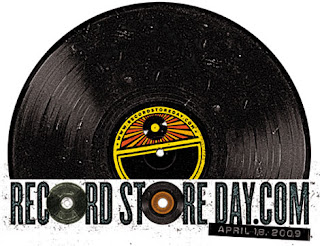I know I claim to be a music fan, but, to be truly honest, I’m more of an album fan at heart. What interests me most is the way songs end up grouped together in some order to create something more than just a random collection of tunes. This is why I’m starting a new monthly column, Great Albums In History, which will feature a detailed look at albums I find particularly important, unique or just plain awesome. To begin this column, I’ve chosen one of my favorites from the 80s, Steely Dan frontman Donald Fagen’s
The Nightfly from 1982.

I find
The Nightfly great because it’s one of the most fully realized concept albums in history. Usually, when you hear the term “concept album,” you think of overblown rock operas by the Who or Meat Loaf, which feature songs trying to tell some elaborate story. Instead,
The Nightfly is a concept album because all the songs are centered on a specific theme: being a young man in the late 1950s. This works much better than a rock opera because each song is allowed to exist on its own, without having to further some plotline along. As we go through each song, you’ll see how each one adds something specific to the bigger picture.
(Note: Since so much of the appeal of this album lies in the lyrics, I’m choosing to focus on Fagen’s words instead of the sleek, glistening music.)
“I.G.Y.”We begin with the gorgeous “I.G.Y.”, which stands for International Geophysical Year. The IGY was an international scientific effort between 1957 and 1958, which aimed to increase the world’s awareness of Earth sciences. In Fagen’s song, the IGY is seen as a glorious beacon of optimism and hope, leading to the chorus of “what a beautiful world this will be, what a glorious time to be free.” Fagen captures a moment in American history where anything seemed possible. Everyone was looking to the future, imagining a time when “there’ll be spandex jackets, one for everyone” and you can “get your ticket to that wheel in space.” Of course, this optimistic thinking would eventually crumble as cynicism took over, but for that brief moment contained within the confident trumpets of “I.G.Y.”, the world seemed like a tremendously exciting place.
“Green Flower Street”As we move along, our narrator (Fagen, presumably) takes us “uptown,” to meet his girl, his “mandarin plum.” There’s no doubt that his “squeeze” on Green Flower St. is a Chinese girl, which, during the late 50s, seems positively radical. Interracial relationships? Gasp! We never know what Fagen’s folks think of his new girl, but we do know that “Lou Chang, her brother, is burning with rage,” since he says “hey buddy, you’re not my kind.” However, Fagen seems excited by all this danger. He celebrates the fact that “uptown, it’s murder out on the street.” He’s a young man and he’s having the time of his life with his Green Flower St. girl.
“Ruby Baby”Another day, another girl. The young Fagen has moved on and found a new object of affection: “I got a girl and Ruby is her name.” There’s just one little problem: “she don’t love me but I love her just the same.” Fagen perfectly captures the sense of loyally waiting for a girl, even when she shows no signs of reciprocating Fagen’s feelings for her. He’s determined to win her heart, however, vowing to “steal you away from all those guys.” In his mind, she’s already his. He’ll shower her with gifts and love. All he needs is a chance. “Ruby, baby, when will you be mine?”
“Maxine”Well, I guess things didn’t work out with Ruby, because Fagen is driving down to Mexico City with his new girl, Maxine. However, she seems like a much better choice and the couple’s doing splendidly. The only problem is their impending graduation, meaning both will have to go off and live real lives. For now, however, they meet every night and “talk about life, the meaning of it all.” They’ve got plenty of plans for the future. “We’ll move up to Manhattan, fill the place with friends.” There’s little chance any of this will happen, but for now, the young, naïve couple are enjoying their dreams.
“New Frontier”“New Frontier” is yet another love song, but this time there’s a twist. The late 50s may have been a time of great optimism, but Americans also lived under the constant threat that “the Reds decide to push the button down.” Yup, it’s time for a love affair in a bomb shelter! Fagen’s found himself a sexy “big blonde” and, being the gentleman he is, he’s inviting her down into “a dugout that my dad built” to wait out the inevitable nuclear winter. Eventually, they’ll “open up the doors and climb out into the dawn.” To Fagen, these are just the realities of modern romance: “prepare to face the challenge of the new frontier.”
“The Nightfly”Of course, there was something else besides love in the air in the late 50s. Rock and roll records were popping up everywhere and many young people would tune their radios furiously, trying to find stations that played this exciting and dangerous new sound. “The Nightfly” celebrates one of those brave DJs, Lester the Nightfly, broadcasting out of Baton Rouge. Lester is a smooth-talking, late-night host, taking calls by crazy, paranoid listeners who say “there’s a race of men in the trees.” Nothing could make Lester happier: “I wait all night for calls like these.” Fueled by coffee and cigarettes, Lester plays his records through the night until dawn. However, for those who might think this is the best job in the world, Lester “feels like crying.” All these late night hours spent alone remind him of a time when “love was in my life.” Sometimes, he wonders “what happened to that flame.” But, for now, his love is for his loyal listeners. He keeps broadcasting on his “independent station, WJAZ, with jazz and conversation, from the foot of Mt. Belzoni.”
“The Goodbye Look”This incredibly silly song deals with some of the most serious issues of the late 50s. Between 1957 and 1959, Fidel Castro led his group of Marxist rebels in a successful revolution of the Cuban government, creating a communist power on America’s doorstep. However, “The Goodbye Look” tells this story from the perspective of a phenomenally dull American tourist, who’s just in Cuba to soak up a few rays. All the fun, the “laughter and steel bands at night,” has been replaced by “a bit of action after dark, behind the big casino on the beach.” Our plucky tourist has noticed “the embassy’s been hard to reach.” And now he’s being woken up by an angry Cuban colonel with a gun. As our hero says, “the rules have changed, it’s not the same, it’s all new players in a whole new ball game.” Thankfully, he’s got a way off the island, thanks to “a fellow with a motor launch for hire.” He’s leaving not a moment too soon: “tonight, they’re arranging a small reception, just for me, behind the big casino by the sea.”
“Walk Between Raindrops”So, after all this time, what has Fagen learned? He’s fallen in love again and again, he’s partied with a girl in a bomb shelter, he’s listened to some exciting rock and roll and he’s escaped the Cuban revolution. Thrilling stuff, right? Well, that boat from Cuba has dropped him off in Miami and, of course, he’s immediately back with some girl. Again, he’s lost in the rush of young love. He’s so giddy, it’s as if he can walk “between the raindrops” of a big Florida storm. In many ways, this can be seen as a metaphor for the album as a whole. Fagen is celebrating growing up in the late 50s, a time when problems were lurking just around the corner. The social upheaval of the 1960s was like a gathering storm on the horizon. But for the young Fagen, he was too busy chasing girls and listening to music to really worry about all that.
The Nightfly reflects that, celebrating life and love despite all the danger the world was offering at the time.



































 I find The Nightfly great because it’s one of the most fully realized concept albums in history. Usually, when you hear the term “concept album,” you think of overblown rock operas by the Who or Meat Loaf, which feature songs trying to tell some elaborate story. Instead, The Nightfly is a concept album because all the songs are centered on a specific theme: being a young man in the late 1950s. This works much better than a rock opera because each song is allowed to exist on its own, without having to further some plotline along. As we go through each song, you’ll see how each one adds something specific to the bigger picture.
I find The Nightfly great because it’s one of the most fully realized concept albums in history. Usually, when you hear the term “concept album,” you think of overblown rock operas by the Who or Meat Loaf, which feature songs trying to tell some elaborate story. Instead, The Nightfly is a concept album because all the songs are centered on a specific theme: being a young man in the late 1950s. This works much better than a rock opera because each song is allowed to exist on its own, without having to further some plotline along. As we go through each song, you’ll see how each one adds something specific to the bigger picture.




 Artist: Neil Young
Artist: Neil Young

 Of course, Metallica got the most attention of the night. With droves of screaming metal heads filling the balconies of the Hall Of Fame museum (which is in Cleveland), James Hetfield, Kirk Hammet, Lars Ulrich and both surviving bassists Jason Newsted and Rob Trujillo (R.I.P. Cliff Burton) made their way on stage to accept their award. The usual humble
Of course, Metallica got the most attention of the night. With droves of screaming metal heads filling the balconies of the Hall Of Fame museum (which is in Cleveland), James Hetfield, Kirk Hammet, Lars Ulrich and both surviving bassists Jason Newsted and Rob Trujillo (R.I.P. Cliff Burton) made their way on stage to accept their award. The usual humble 
